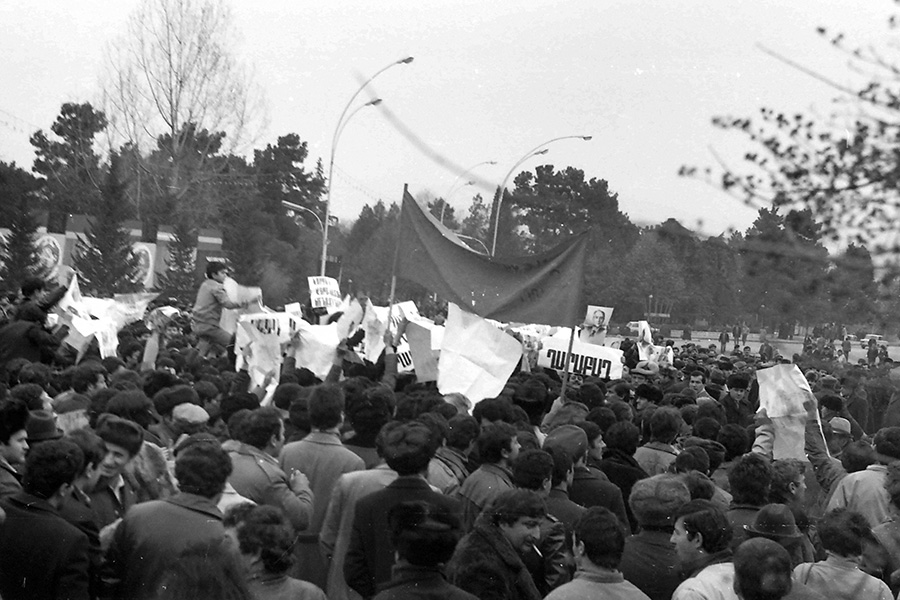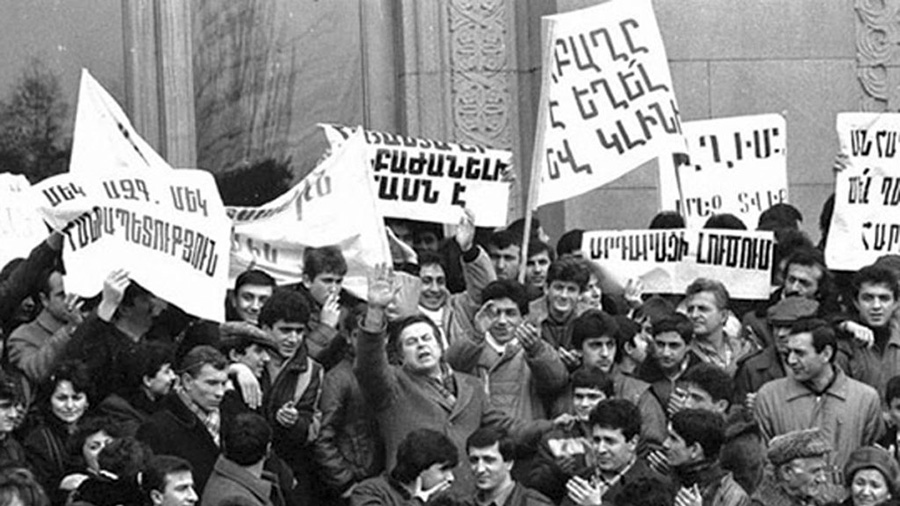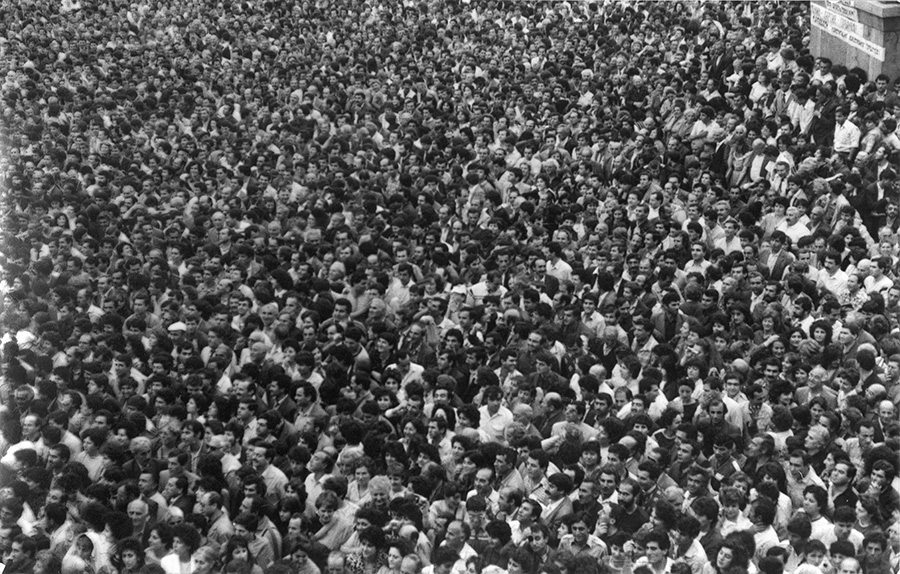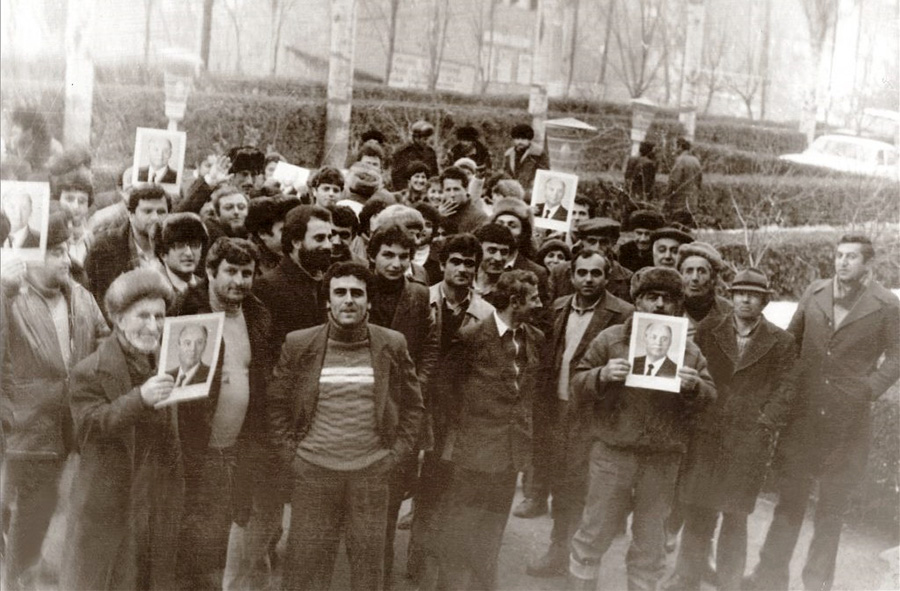The movement that commenced in February 1988 in the Nagorno-Karabakh Autonomous Oblast (NKAO) of the Azerbaijan Soviet Socialist Republic (SSR), titled “Miatsum” (“Unification”), was inherently democratic. It aligned with the principles of freedoms declared in the Soviet Union after 1985.
At the outset, before the establishment of a rigid single-party rule, the “Soviets” were conceived and brought to life as a means of expressing the will and aspirations of the people. With Mikhail Gorbachev coming to power and initiating the course of perestroika (“reconstruction”), democratization and glasnost (“openness”), he indirectly hinted at the possibility of using the Soviets as such a means.

During the initial period of Gorbachev’s rule (until 1988), there was an impression that by employing this measure—legally, without violating the general order and the integrity of the Soviet country—it was possible to address certain long-standing issues, particularly those circulating throughout the preceding decades but remaining unaddressed.
The Nagorno-Karabakh Armenian region, annexed to Soviet Azerbaijan by the decision of the Caucasus Bureau in 1923, constituted one such issue. As a problem longing for a solution, it was regularly placed on the table of Moscow leaders in various formulations since the 1930s.
In 1936, on the eve of the adoption of the new Constitution of the USSR, when the Transcaucasian SFSR (Transcaucasian Socialist Federative Soviet Republic) was set to be divided into three republics, Aghasi Khanjyan, the First Secretary of the Armenian Communist Party, hinted at the expediency of including Nagorno-Karabakh into Armenia.
 In the years 1945-1948, on three occasions, Grigor Harutyunyan, the Secretary of the Armenian Communist Party, proposed to Stalin the incorporation of Nagorno-Karabakh into Armenia. He explained the necessity of this territorial reshaping with the commenced repatriation and the urgency of settling the immigrants.
In the years 1945-1948, on three occasions, Grigor Harutyunyan, the Secretary of the Armenian Communist Party, proposed to Stalin the incorporation of Nagorno-Karabakh into Armenia. He explained the necessity of this territorial reshaping with the commenced repatriation and the urgency of settling the immigrants.
In 1961, when Nikita Khrushchev visited Armenia, the First Secretary of the Armenian Communist Party, Yakov Zarobyan also raised the Karabakh issue.
Beside all these efforts, the Kremlin received letters with thousands of signatures from Armenia and Nagorno-Karabakh, which went unanswered. The hope of resolving the issue at the top was exhausted. It was necessary to try “from below” and Gorbachev’s perestroika seemed to provide that opportunity.
 On February 13, 1988, mass rallies began in Nagorno-Karabakh, intensifying with strikes in the subsequent days. Local Armenian residents demanded the convening of a regional council session and the adoption of the decision to incorporate Azerbaijani-subjected Nagorno-Karabakh Autonomous Oblast into Armenia.
On February 13, 1988, mass rallies began in Nagorno-Karabakh, intensifying with strikes in the subsequent days. Local Armenian residents demanded the convening of a regional council session and the adoption of the decision to incorporate Azerbaijani-subjected Nagorno-Karabakh Autonomous Oblast into Armenia.
 Despite all the obstacles, the session took place on February 20, and the decision was adopted. For the first time in the history of the Soviet Union, the power body made a decision “from below” without the consent of a superior Soviet or party body, and moreover, against its will.
Despite all the obstacles, the session took place on February 20, and the decision was adopted. For the first time in the history of the Soviet Union, the power body made a decision “from below” without the consent of a superior Soviet or party body, and moreover, against its will.
…and this legal expression of will was perceived as rebellion
On the same day, the troops of the Soviet Union’s Ministry of Internal Affairs were already in Stepanakert. Were they there to suppress the rebellion? No, the aim was to keep the situation under control.
On February 20, when Opera Square (now Freedom Square) was filled with tens of thousands of people within a matter of hours and Armenia joined the movement that started in Nagorno-Karabakh a few days ago, no doubts remained among Gorbachev and his entourage that what was happening was a rebellion.
 The Moscow party periodicals were not using the word “rebellion” (восстание) but were not concealing their concern and fear, labeling the phenomenon as extremism (экстремизм).
The Moscow party periodicals were not using the word “rebellion” (восстание) but were not concealing their concern and fear, labeling the phenomenon as extremism (экстремизм).
Surprised by the momentum of the uprising, Moscow immediately condemned the Movement through the decision of the Central Committee of the Communist Party of the Soviet Union, labeling its participants as “extremists” and “nationalists”. This occurred although the participants of the peaceful protest were waving the flag of the Soviet Union, holding the portraits of Lenin and Gorbachev and chanting slogans that were far from being extremist.
 Neither in Armenia nor in Karabakh was anyone rebelling against Soviet power or order at that time. The Karabakh Movement was a struggle for self-determination. Self-determination was not something unusual; its right was even enshrined in the USSR Constitution.
Neither in Armenia nor in Karabakh was anyone rebelling against Soviet power or order at that time. The Karabakh Movement was a struggle for self-determination. Self-determination was not something unusual; its right was even enshrined in the USSR Constitution.
If, for instance, the three Baltic Republics considered that clause of the Constitution as an opportunity to separate from the USSR—to secede a part—the demand raised in the case of the Karabakh Movement apparently did not threaten the integrity of the union. It was an issue of internal self-determination, nevertheless, more dangerous.
Thus, either Moscow had to employ brutal methods to suppress the movement that started in Stepanakert and Yerevan, or it had to come up with a solution. Both options were highly dangerous for the country that embarked on the path of reforms.
If, in the first case, the USSR was to lose the opportunity to enhance its international reputation through political reforms, then in the second case, there was a risk that new separatist movements would start in the multi-ethnic Soviet country.
On the evening of February 22, in his television speech, Karen Demirchyan, the First Secretary of the Communist Party of Armenia, characterized the Artsakh movement in line with the decision adopted by the Central Committee of the Communist Party of the Soviet Union on the previous day. Specifically, he stated that “the actions and demands aimed at reshaping the existing ethno-territorial structure contradict the interests of Armenian and Azerbaijani workers”.
To be continued
Tigran Paskevichyan
